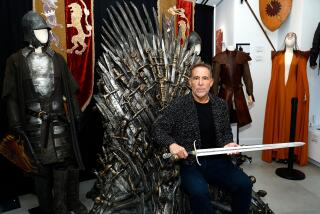LAGUNA HILLS : Fillmore Fans Buy Bit of History
- Share via
It was standing-room only at the Millard G. Fillmore estate sale Thursday as harried Leisure World guards turned away a throng of media and the curious who arrived to get a peek at personal effects belonging to the 13th President.
Fans of the much-castigated Fillmore came from as far away as New York to bid on items ranging from a $3,000 presidential chair to long underwear belonging to Fillmore’s son.
“I don’t really care what they say about him, this is fun,” said Genia Schafer of La Mirada, who paid $50 for what she thought were a pair of presidential long johns.
The underwear was actually worn by his son Millard D. Fillmore, but that didn’t matter much to Schafer. “I’m not sure what I’m going to do with this, but it’s not every day you get to buy a President’s stuff,” she said.
Experts in political memorabilia said the sale, which continues today, is a rare opportunity for the public to buy presidential possessions. And Fillmore’s reputation as one of the worst Presidents in the nation’s history didn’t hurt sales Thursday, said Karen Vicker, manager of the estate liquidation, who reported doing a brisk business.
Customers included curators from the White House, which keeps a collection of presidential artifacts. White House representatives bought a silver sugar bowl belonging to Fillmore’s wife, Abigail, and two pictures of the former First Lady.
“We’ve really had an incredible response from all over the country,” said William Anderson, who inherited the Fillmore collection from Clara Allard, whose sister was married to the President’s great-grandson. “Some of these things look gaudy to me, but they have historical significance, and people are really getting pleasure out of this sale.”
Vice President Fillmore took over the reins of a deeply divided country in 1850 when President Zachary Taylor died. As the states split apart over the issue of slavery, Fillmore tried to patch up their differences by signing into law a series of compromise measures.
The most significant was the Fugitive Slave Act, which allowed the return of escaped slaves from the Northern states.
But historians say that straddling the fence accomplished nothing and only delayed the Civil War that followed.
“He offered compromise after compromise that didn’t settle the differences” between Northern and Southern states, said Keith Melder, curator of political history at the Smithsonian Institution in Washington. “Rather than solving anything, he only postponed the inevitable.”
Some historians have taken Fillmore’s side, saying the beleaguered President took office at a difficult time in history.
In recent years, Fillmore’s reputation has helped win him the affection of an irreverent group of supporters in fan clubs scattered across the country. Every Jan. 7, groups such as the Western States Millard G. Fillmore Appreciation Society in Walnut Creek in Northern California hold parties for the former President on his birthday.
But Millard Fillmore is serious business in New York, where he was born and retired after leaving office in 1852. In Buffalo, where Fillmore helped establish a university and a hospital, his statue still stands outside City Hall.
“Here, we know him because of the many cultural institutions he involved himself in,” said Clyde Eller, a director of the Buffalo and Erie County Historical Society’s museum collection. “We feel that many of his critics were misdirected. He will always be remembered here as a great citizen.”
More to Read
Sign up for Essential California
The most important California stories and recommendations in your inbox every morning.
You may occasionally receive promotional content from the Los Angeles Times.









